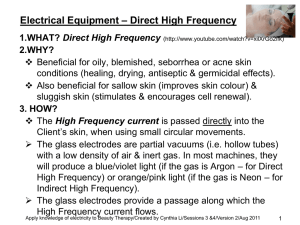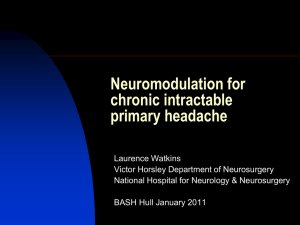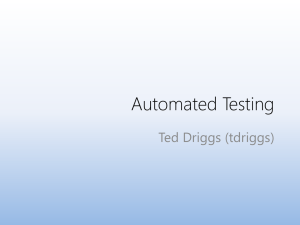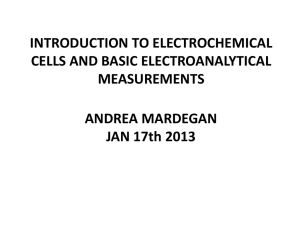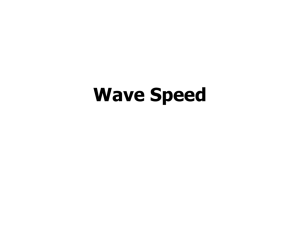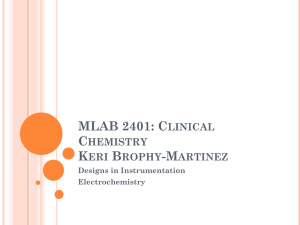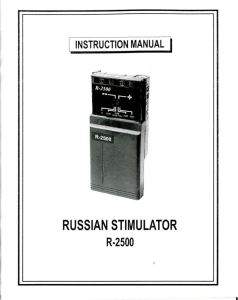Stimulation Field Smoothing using Multiple Independent Current
advertisement
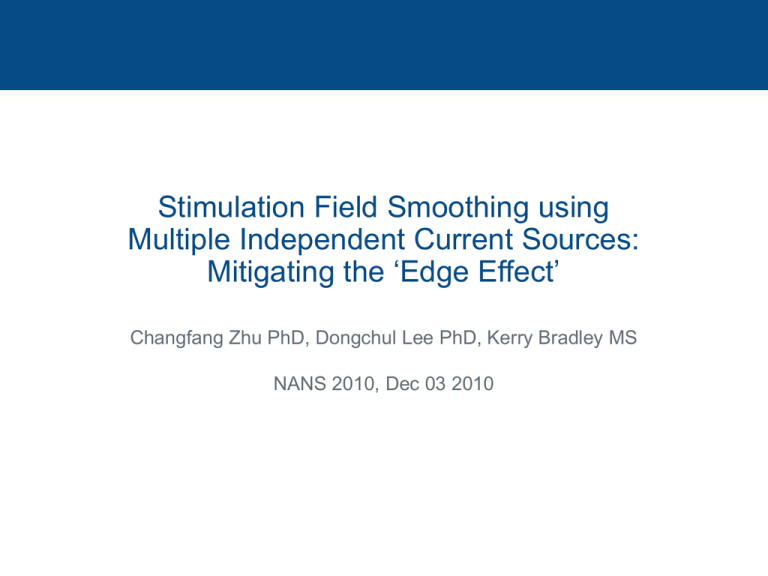
Stimulation Field Smoothing using Multiple Independent Current Sources: Mitigating the ‘Edge Effect’ Changfang Zhu PhD, Dongchul Lee PhD, Kerry Bradley MS NANS 2010, Dec 03 2010 Disclaimers All authors are employees of Boston Scientific Neuromodulation Subcutaneous electrical stimulation is not approved by the Food and Drug Administration for Boston Scientific Implantable Neuromodulation Systems 2 Introduction To nerve fibers near the contact array: A single cathode creates a limited focal stimulation region Programming multiple contacts as a “string of cathodes” however, can create a wider stimulation region 3 A Well-known Electrode Characteristic: the “Edge Effect” Current density is non-uniform over the electrode surface and is highest at the edges I0 * Jr 2a 2 [1 (r a) 2 ]1/ 2 2 2 J / J0 (J0 = I0/a ) 2.5 1.5 I0: Total current into the electrode 1 a: radius of circular disc electrode 0.5 0 -1 * Wiley and Webster, IEEE-BME 1982 -0.5 0 0.5 1 r/a > 50% of total current -1 -0.5 0 0.5 1 4 -1 -0.5 0 0.5 1 Current Density on a String of Electrodes? When a string of electrodes are connected to a single current source – What does the current density look like on each electrode? What is the clinical effect of the current distribution? I ?? 5 ?? ? ? ?? Computational Simulation Using a computational model, we simulated the current density on each contact of a percutaneous lead with the following contact size and spacing: 3 mm 6 4 mm Current Density on a String of Electrodes Connected to a Single Source (SS) I “Hot spots” Single electrode source equivalent current(%) - SS 20 7 % of delivered current % of delivered current Single point source equivalent current(%) - SS 15 10 5 0 E1 E2 E3 E4 E5 E6 E7 E8 15 10 5 0 E1 E2 E3 E4 E5 E6 E7 E8 Edge Effect on a String of Electrodes I = 8 Effect on Neural Recruitment near Contact Array: Simulation Settings Infinite, homogeneous and isotropic medium Sheets of fibers running orthogonal to the electrode string, two fiber diameters: A-β: 12 µm A-δ: 7 µm Distance of fiber sheets to electrodes: 1 ~ 10 mm Observe: • Location and threshold of first A-β & A-δ activation • Extent of A-β activation prior to the first A-δ activation 9 I Effect on Neural Recruitment near Contact Array: Extent of A-β Activation with Single-Source Z (0.5 mm) At Z = 3.5 mm 10 Current Density on a String of Electrodes Connected to Multiple Independent Current Sources (MICS) Single point source equivalent current(%) - MICC 20 11 % of delivered current % of delivered current Single point source equivalent current(%) - MICC 15 10 5 0 E1 E2 E3 E4 E5 E6 E7 E8 15 10 5 0 E1 E2 E3 E4 E5 E6 E7 E8 Effect on Neural Recruitment near Contact Array: Extent of A-β Activation with MICS Z (0.5 mm) At Z = 3.5 mm 12 Comparison Single Source (SS) 13 Multiple Independent Current Source (MICS) Conclusions Using a single source, the outer edges of the string have the highest current density, resulting in unbalanced fiber activation across the string The use of MICS can effectively “smooth” out the stimulation field: – provides more consistent activation across the string of contacts – activates deeper regions near the middle of the contact array 14

